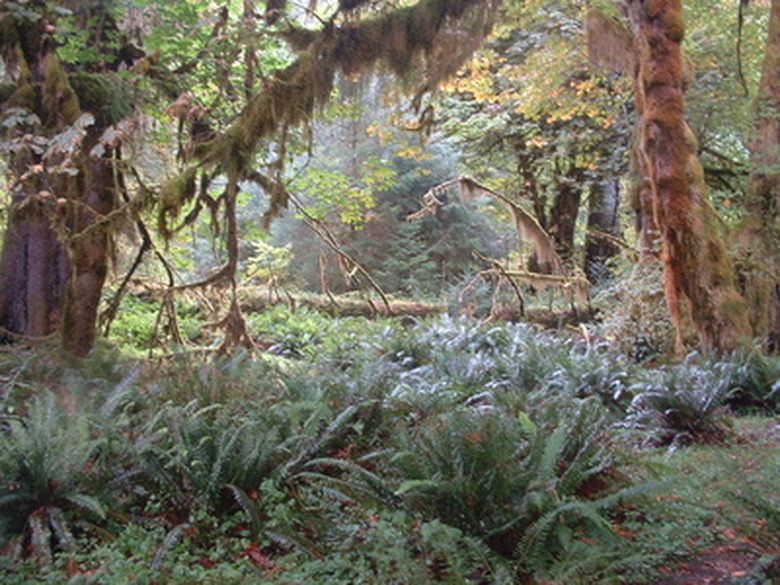What Kinds Of Plants Are In The Central American Tropical Rain Forest?
The Central American rainforest spans southern Mexico, Belize, Guatemala, El Salvador, Honduras, Nicaragua, Costa Rica and Panama.
This area was once widespread with rainforest but is now highly fragmented due to habitat destruction for farming cane sugar, cattle, burning, hunting and agriculture. Central American rainforests have a high biodiversity of tropical plants with unique adaptations to cope with the humid environment.
Rainforest Producers
Rainforest Producers
Primary producers called autotrophs are at the base of a food web. Autotrophs are organisms that use their environment to make their own food such as plants, algae, some fungi and bacteria.
Without the multitudes of plants in Central America rainforests, animals such as spider monkeys, howler monkeys, agouti, jaguar, sloths, crocodiles, hummingbirds, tarantulas and leaf-cutter ants wouldn't be able to survive.
Adaptations of Rainforest Plants
Adaptations of Rainforest Plants
Rainforest trees tend to have thinner bark as moisture loss from evaporation is not as much of a concern in humid environments.
Many trees also feature massive buttresses that help keep them stable to make up for shallow root systems in the soft soils. Leaves of rainforest plants often feature a drip tip, which is thought to help channel water runoff as a coping mechanism during heavy rain events.
Many rainforest plants are epiphytes that can grow on the sides of trees. This allows them to reach the sunlight they wouldn't get from the forest floor. Numerous vines hanging from the canopy are called lianas. To take advantage of the sunlight, lianas start their lives in the canopy, and their roots grow down, eventually reaching the forest floor.
Bromeliads are a common epiphyte in the rainforests. Bromeliads use their cuplike shape to capture water. This water source often serves as home to tadpoles, dragonfly and mosquito larvae, bacteria, frogs or birds, and it delivers extra nutrients to the plant.
Adaptations of Rainforest Flowers
Adaptations of Rainforest Flowers
Vibrant Heliconia spp. are widespread in the neotropical rainforests of Central America and the Amazon in South America. Distinctive drooping, brightly colored "parrot beak" inflorescences attract hummingbirds and butterflies to feed off nectar and pollinate the many tiny flowers inside.
Some heliconia species face upwards to attract birds by providing a water source.
There are more than 22,000 species of orchids worldwide, each with unique adaptations. Most orchids are epiphytes and can come in nearly every color, except black, to attract bird and insect pollinators.
Vanilla, Vanilla planifolia, is a climbing orchid specially designed for rainforest environments. Creamy white and yellow vanilla flowers open for a mere 24 hours to be pollinated by small native bees.
Economically Valuable Rainforest Plants
Economically Valuable Rainforest Plants
The high biodiversity in the rainforests means that there are many plants highly valued for food, medicine, clothing and religious purposes.
While we are aware of many economically valuable plants, there are still many yet to be studied. Because of this, conserving Central American rainforests is crucial to everyone, not just indigenous people and native animals.
Cacao
Cacao
Theobroma cacao or "food of the gods" is a well-known plant of Central America and is sacred to the Mayans. Ancient Mayan artifacts indicate that people purposefully planted and cultivated cacao. There is evidence that Mayan and Aztec civilizations may have used cacao beans for trading, as a currency, as well as consumed it as a hot beverage for pleasure, health and rituals.
When cacao beans are roasted and ground, they produce cocoa butter, the key ingredient used for making chocolate.
Rubber Tree
Rubber Tree
Castilla elastica, a.k.a. the Panama rubber tree, was first used to produce latex by the Mesoamerican people before the arrival of Colombus.
Due to humans, the rubber tree now can now be found in rainforests in some African countries, Australia and many of the Pacific Islands. Mammals and birds spread the rubber tree seeds around the forest for dispersal.
Papaya
Papaya
Papaya, Carica papaya, is a large orange fruit with small black seeds the size of peppercorns in the center. Papaya trees require the warm temperatures of Central America to grow and rapidly produce fruit.
As well as being a delicious fruit, papaya may be beneficial for stomach ache, digestive issues, diarrhea and cancer. A study published in the Journal of Medicinal Food found that air-dried papaya seeds were potentially effective for the treatment and prevention of intestinal parasites in humans.
Avocado
Avocado
Avocado, Persea americana, locally known in Spanish as aguacate, grows in Central American highlands and rainforests. Avocado fruit is a highly nutritious food source.
The leaves of avocado trees have been found to potentially aid cancer, wound healing and body pain. Avocados are now cultivated worldwide.
References
- Missouri Botanical Garden: Rainforest Plants
- Marietta College: The Tropical Rainforest
- National Geographic: Autotroph
- Evidence-Based Complementary and Alternative Medicine: Medicinal Plants From Mexico, Central America, and the Caribbean Used as Immunostimulants
- Journal of Medicinal Food: Effectiveness of Dried Carica Papaya Seeds Against Human Intestinal Parasitosis: A Pilot Study
- Cacao Diseases: Origin, Dispersal, and Current Global Distribution of Cacao Genetic Diversity
- Science: The Maya Civilization Used Chocolate as Money
- Cornell University: How the Aztecs Prepared Chocolate
- Bio Net-EAFRINET: Castilla Elastica (Panama Rubber Tree)
- WWF: Protecting the Rainforests of Central America
- WWF: Central America: Patches Scattered Through Mexico, Guatemala, Honduras, El Salvador, Nicaragua, and Costa Rica
- Rainforest Alliance: Heliconia
- Exploring Florida: Heliconia Rostata
- Rainforest Alliance: Orchid
- Smithsonian Gardens: Orchids of Latin America
- The American Orchid Society: Peristeria
- Encyclopaedia Britannica: Vanilla
Cite This Article
MLA
Jerrett, Adrianne. "What Kinds Of Plants Are In The Central American Tropical Rain Forest?" sciencing.com, https://www.sciencing.com/kinds-american-tropical-rain-forest-6688492/. 22 November 2019.
APA
Jerrett, Adrianne. (2019, November 22). What Kinds Of Plants Are In The Central American Tropical Rain Forest?. sciencing.com. Retrieved from https://www.sciencing.com/kinds-american-tropical-rain-forest-6688492/
Chicago
Jerrett, Adrianne. What Kinds Of Plants Are In The Central American Tropical Rain Forest? last modified August 30, 2022. https://www.sciencing.com/kinds-american-tropical-rain-forest-6688492/
